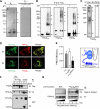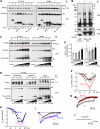Oligomerization of Cavbeta subunits is an essential correlate of Ca2+ channel activity
- PMID: 20732952
- PMCID: PMC2992367
- DOI: 10.1096/fj.10-165381
Oligomerization of Cavbeta subunits is an essential correlate of Ca2+ channel activity
Abstract
Voltage-gated calcium channels conduct Ca(2+) ions in response to membrane depolarization. The resulting transient increase in cytoplasmic free calcium concentration is a critical trigger for the initiation of such vital responses as muscle contraction and transcription. L-type Ca(v)1.2 calcium channels are complexes of the pore-forming α(1C) subunit associated with cytosolic Ca(v)β subunits. All major Ca(v)βs share a highly homologous membrane associated guanylate kinase-like (MAGUK) domain that binds to α(1C) at the α-interaction domain (AID), a short motif in the linker between transmembrane repeats I and II. In this study we show that Ca(v)β subunits form multimolecular homo- and heterooligomeric complexes in human vascular smooth muscle cells expressing native calcium channels and in Cos7 cells expressing recombinant Ca(v)1.2 channel subunits. Ca(v)βs oligomerize at the α(1C) subunits residing in the plasma membrane and bind to the AID. However, Ca(v)β oligomerization occurs independently on the association with α(1C). Molecular structures responsible for Ca(v)β oligomerization reside in 3 regions of the guanylate kinase subdomain of MAGUK. An augmentation of Ca(v)β homooligomerization significantly increases the calcium current density, while heterooligomerization may also change the voltage-dependence and inactivation kinetics of the channel. Thus, oligomerization of Ca(v)β subunits represents a novel and essential aspect of calcium channel regulation.
Figures





Similar articles
-
New Determinant for the CaVbeta2 subunit modulation of the CaV1.2 calcium channel.J Biol Chem. 2008 Jun 6;283(23):15577-88. doi: 10.1074/jbc.M802035200. Epub 2008 Apr 14. J Biol Chem. 2008. PMID: 18411278 Free PMC article.
-
Calmodulin-dependent gating of Ca(v)1.2 calcium channels in the absence of Ca(v)beta subunits.Proc Natl Acad Sci U S A. 2008 Jun 10;105(23):8154-9. doi: 10.1073/pnas.0711624105. Epub 2008 Jun 5. Proc Natl Acad Sci U S A. 2008. PMID: 18535142 Free PMC article.
-
A CaVbeta SH3/guanylate kinase domain interaction regulates multiple properties of voltage-gated Ca2+ channels.J Gen Physiol. 2005 Oct;126(4):365-77. doi: 10.1085/jgp.200509354. J Gen Physiol. 2005. PMID: 16186563 Free PMC article.
-
The ß subunit of voltage-gated Ca2+ channels.Physiol Rev. 2010 Oct;90(4):1461-506. doi: 10.1152/physrev.00057.2009. Physiol Rev. 2010. PMID: 20959621 Free PMC article. Review.
-
Vascular calcium channels and high blood pressure: pathophysiology and therapeutic implications.Vascul Pharmacol. 2006 Mar;44(3):131-42. doi: 10.1016/j.vph.2005.10.005. Epub 2006 Jan 20. Vascul Pharmacol. 2006. PMID: 16427812 Free PMC article. Review.
Cited by
-
Molecular Determinants of Cav1.2 Calcium Channel Inactivation.ISRN Mol Biol. 2012 Oct 17;2012:691341. doi: 10.5402/2012/691341. eCollection 2012. ISRN Mol Biol. 2012. PMID: 27335667 Free PMC article. Review.
-
Structural and biophysical analyses of the skeletal dihydropyridine receptor β subunit β1a reveal critical roles of domain interactions for stability.J Biol Chem. 2017 May 19;292(20):8401-8411. doi: 10.1074/jbc.M116.763896. Epub 2017 Mar 28. J Biol Chem. 2017. PMID: 28351836 Free PMC article.
-
Inhibitory effects on L- and N-type calcium channels by a novel CaVβ1 variant identified in a patient with autism spectrum disorder.Naunyn Schmiedebergs Arch Pharmacol. 2022 Apr;395(4):459-470. doi: 10.1007/s00210-022-02213-7. Epub 2022 Feb 5. Naunyn Schmiedebergs Arch Pharmacol. 2022. PMID: 35122502 Free PMC article.
-
Impacts of CACNB4 overexpression on dendritic spine density in both sexes and relevance to schizophrenia.Transl Psychiatry. 2024 Dec 4;14(1):484. doi: 10.1038/s41398-024-03181-7. Transl Psychiatry. 2024. PMID: 39632796 Free PMC article.
-
Structure and function of the β subunit of voltage-gated Ca²⁺ channels.Biochim Biophys Acta. 2013 Jul;1828(7):1530-40. doi: 10.1016/j.bbamem.2012.08.028. Epub 2012 Sep 7. Biochim Biophys Acta. 2013. PMID: 22981275 Free PMC article. Review.
References
-
- Westenbroek R. E., Ahlijanian M. K., Catterall W. A. (1990) Clustering of L-type Ca2+ channels at the base of major dendrites in hippocampal pyramidal neurons. Nature 347, 281–284 - PubMed
-
- Catterall W. A. (2000) Structure and regulation of voltage-gated Ca2+ channels. Annu. Rev. Cell Dev. Biol. 16, 521–555 - PubMed
Publication types
MeSH terms
Substances
Grants and funding
LinkOut - more resources
Full Text Sources
Miscellaneous

